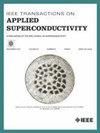High-Capacity DFF Cells for Unary Computing Using Single-Flux Quantum Circuits
IF 1.8
3区 物理与天体物理
Q3 ENGINEERING, ELECTRICAL & ELECTRONIC
引用次数: 0
Abstract
Due to their high-speed operation and low power consumption, single-flux quantum (SFQ) circuits are promising technologies for integrated circuits. However, current superconducting fabrication limitations impose strict area constraints, challenging the construction of large-scale systems. Unary computing (UC) encodes numerical values by concentrating all “1”s at the beginning of a bit sequence. This approach enables arithmetic operations with fewer logic gates, thereby improving the area efficiency. In this article, we propose a novel high-capacity D flip-flop (HC-DFF) cell for UC-based SFQ circuits that achieves high-density data registration while preserving UC encoding. The HC-DFF employs a cascaded storage loop structure in which each loop sequentially stores one flux quantum, avoiding the margin deterioration associated with storing multiple flux quanta in a single loop. Simulation shows that the proposed HC-DFF achieves a bias margin of –20.8% to +32.7% and supports read/write operations above 100 GHz. We fabricated the HC-DFF using a 10 kA/cm2 Nb four-layer superconducting process and verified its operation through low-speed measurements. The HC-DFF offers enhanced scalability and stability while reducing the number of required Josephson junctions by 83.3% per bit compared to conventional DFF-based shift registers for saving UC signals. For short unary sequences of less than 31 bits, it retains an advantage over storing binary data with equivalent precision using conventional DFF-based shift registers.基于单通量量子电路的一元计算高容量DFF单元
单通量量子电路(SFQ)由于其高速运行和低功耗的特点,是集成电路中很有前途的技术。然而,目前的超导制造限制施加了严格的面积限制,对大规模系统的构建提出了挑战。一元计算(UC)通过集中位序列开头的所有“1”来编码数值。这种方法可以用更少的逻辑门进行算术运算,从而提高了面积效率。在本文中,我们提出了一种新型的高容量D触发器(HC-DFF)单元,用于基于UC的SFQ电路,在保持UC编码的同时实现高密度数据配准。HC-DFF采用级联存储环路结构,其中每个环路顺序存储一个通量量子,避免了在单个环路中存储多个通量量子相关的余量恶化。仿真结果表明,所提出的HC-DFF实现了-20.8% ~ +32.7%的偏置裕度,支持100ghz以上的读写操作。我们采用10 kA/cm2的铌四层超导工艺制备了HC-DFF,并通过低速测量验证了其可操作性。HC-DFF提供了增强的可扩展性和稳定性,同时与传统的基于dff的移位寄存器相比,每比特所需的约瑟夫森结数量减少了83.3%,用于保存UC信号。对于小于31位的一元短序列,它比使用传统的基于dff的移位寄存器存储具有同等精度的二进制数据具有优势。
本文章由计算机程序翻译,如有差异,请以英文原文为准。
求助全文
约1分钟内获得全文
求助全文
来源期刊

IEEE Transactions on Applied Superconductivity
工程技术-工程:电子与电气
CiteScore
3.50
自引率
33.30%
发文量
650
审稿时长
2.3 months
期刊介绍:
IEEE Transactions on Applied Superconductivity (TAS) contains articles on the applications of superconductivity and other relevant technology. Electronic applications include analog and digital circuits employing thin films and active devices such as Josephson junctions. Large scale applications include magnets for power applications such as motors and generators, for magnetic resonance, for accelerators, and cable applications such as power transmission.
 求助内容:
求助内容: 应助结果提醒方式:
应助结果提醒方式:


